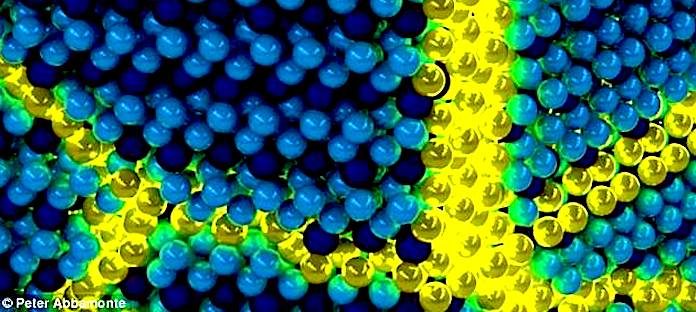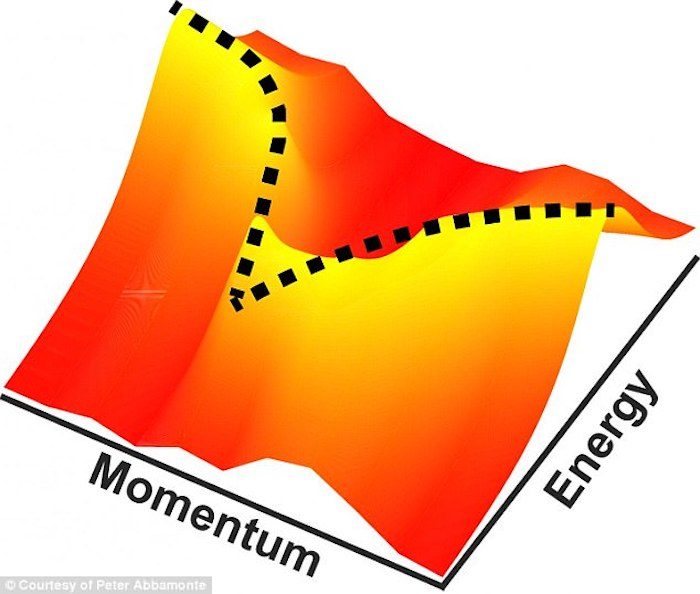
Excitonium is made up of particles known as excitons, which are made from an escaped electron and the hole it left behind.In the new experiments, the researchers say they were able to observe the material and the precursor phase, which is said to be the 'smoking gun' proof of its existence.
According to the researchers, excitonium is what's known as a condensate.
This means it exhibits macroscopic quantum phenomenon, like a superconductor, superfluid, or insulating electronic crystal.
It was first theorized nearly 50 years ago, and researchers now say they've confirmed its existence.
When an electron gets excited and 'jumps', it leaves behind a hole. And, this hole can behave as though it were a particle itself, with a positive charge. As it has a positive charge, the hole attracts the electron, pairing them to form a composite particle, or boson, known as an exciton.
In the new experiments, the researchers studied non-doped crystals of the transition metal dichalcogenide titanium diselenide (1T-TiSe2).
According to the team from the University of Illinois College of Engineering, they were able to reproduce the results five times on different cleaved crystals. Previous efforts have struggled to distinguish the material from what's known as a Peierls phase, which is unrelated but shares the same symmetry as exciton formation.
To uncover the elusive form of matter, the researchers developed a new technique called momentum-resolved electron energy-loss spectroscopy (M-EELS), which is more sensitive to excitations than other methods. The researchers retrofit an EEL spectrometer with a goniometer, to precisely measure the electron's momentum. And, doing this allowed them to measure excitations of the particles for the first time.
They were even able to observe what they say is the 'smoking gun proof', by spotting the precursor to the excitation - a soft plasmon phase that appears as the material approached its critical temperature.
"This result is of cosmic significance," says Professor of Physics Peter Abbamonte. Ever since the term 'excitonium' was coined in the 1960s by Harvard theoretical physicist Bert Halperin, physicists have sought to demonstrate its existence.

According to the researchers, the discovery could help to unravel a number of other quantum mysteries.
"I remember Anshul being very excited about the results of our first measurements on TiSe2," said graduate student Mindy Rak. We were all standing at a whiteboard in the lab as he explained to me that we had just measured something that no one had seen before: a soft plasmon. The excitement generated by this discovery remained with us throughout the entire project.
"The work we did on TiSe2 allowed me to see the unique promise our M-EELS technique holds for advancing our knowledge of the physical properties of materials and has motivated my continued research on TiSe2."



Reader Comments
negative and positive are two parts of one - that we might see as zero point.
Is this the drip drip drip PR of "science is a cutting edge of exciting new discoveries"?
Rather than narrative control masking of already known but suppressed plasma science by means of media manipulation and (often gargantuan) study funding?
The state of charge-distribution is instant relation in any given moment and yet within an unfolding of infinitely rich relationships is process of changing states or transformation. Where the particular processes of transformation are recognized as expressions of the Field - rather than as caused by one part upon another - is a shifting from energy manipulation to energy information.
Now it may be that what I wrote is made up bollocks - but I listened and felt and wrote it from a desire to participate in an energetic exchange - and not in search of funding, under the aegis of social engineering/mind manipulation.
Yes